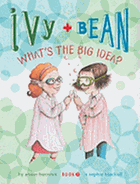
This seventh episode about unlikely best friends Ivy and Bean may be the most ambitious and triumphant yet. As Ms. Aruba-Tate's second grade class prepares for the science fair, they set out to solve the problem of global warming.
The book begins with Bean banished to the backyard for stapling "things that weren't supposed to be stapled." She takes a keen interest in some ants coming and going from a hole in the ground. "To them, she was like a planet," Bean thinks. "She was too big and too far away for them to see." Then she wonders if someone is also watching her: "What if she was as small as an ant compared to that someone?" Bean's close observation of one of nature's smallest creatures has led her to life's larger questions. Then comes a flash of that brilliant balance of wonder and humor that characterizes Barrows and Blackall's work on this series: "Wow. Bean waved at the sky. Hi out there," and a thought balloon pictures an ant with Bean's facial expression and hairstyle.
Barrows lays out how early the sense of responsibility for the environment begins for children. At school, Bean learns from a team of "fifth-grade scientists" that the planet is not in very good shape. Adrian holds a poster of the Gobi Desert while his fifth-grade classmate Shayna explains, "Pretty soon almost everywhere is going to look like this because of global warming." As Juan holds up his poster of "a worried-looking polar bear," Shayna proclaims, "Global warming is a total disaster and it's all our fault." Blackall depicts Ivy and Bean after school, slumped on a bench outside their classroom. "Watcha doing?" asks Leo, who--as a peer in a different class--often serves as a catalyst for the duo in their adventures. "We're worrying about the polar bears," Ivy answers. Leo tries to tempt them with a game of stomp tag, but Ivy tells Leo about the pollution from cars, "and cow poop," adds Bean. At home that evening, Bean discovers that her parents already know about global warming and the polar bears. "Ha! That's nothing," says Bean's older sister, Nancy. "Just wait until you find out about the oceans." Anxious Bean goes into the backyard and pats the patch of earth where the ants live: "Poor ants."
Ms. Aruba-Tate once again comes across as a responsive, compassionate teacher. When the children tell her they "hate science," she wants to get to the root of their change of heart. Readers, of course, have a leg up on the teacher; they know it's the fifth-grade global warming report that caused the class's turnabout. Ms. Aruba-Tate makes a model statement: "People who care as much as you do are the people who will find solutions to the problem.... Science is the solution, not the problem." Ms. Aruba-Tate suggests they make this the theme for their science fair projects--"ideas that fight global warming.... What we need for this problem is new ideas. And you kids are great at that," she says.
Barrows and Blackall know just how to expose situations that are familiar to second-graders—with empathy and a light touch. While Ivy and Bean sit at Bean's kitchen table and think, Bean's dad comes in and asks them what they're up to. He says, "Easy. Get rid of cars." Bean responds, "Dad, we're seven. We don't have cars. We need something we can do for a science fair." When he next suggests that they make a poster reminding people to turn off the lights ("Lights out when you're out!"), Blackall's depiction of Bean's what-is-there-to-say? look to Ivy speaks volumes. The pals try a few funny but dead-end ideas of their own (involving ice cubes and trampolines, tying their hands together to appear weak to nature's creatures, and breaking rice into bits of energy).
Here is Barrows's gift: She keeps Ivy and Bean's anxiety and problem-solving skills squarely in the realm of second-grade thinking. She shows readers Ivy and Bean's line of logic, and then surprises us with the project results on Science Fair night. (A moment of high hilarity comes with Blackall's image of a classmate's demonstration of cutting back on carbon dioxide by having her five siblings hold their breath at timed intervals.) Ultimately, Ivy and Bean arrive at a brilliant, even touching solution to a timely problem.

